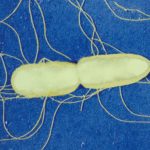Link to Pubmed [PMID] – 31708892
Link to DOI – 10.3389/fmicb.2019.02413
Front Microbiol 2019 ; 10(): 2413
The investigation of foodborne outbreaks (FBOs) from genomic data typically relies on inspecting the relatedness of samples through a phylogenomic tree computed on either SNPs, genes, kmers, or alleles (i.e., cgMLST and wgMLST). The phylogenomic reconstruction is often time-consuming, computation-intensive and depends on hidden assumptions, pipelines implementation and their parameterization. In the context of FBO investigations, robust links between isolates are required in a timely manner to trigger appropriate management actions. Here, we propose a non-parametric statistical method to assert the relatedness of samples (i.e., outbreak cases) or whether to reject them (i.e., non-outbreak cases). With typical computation running within minutes on a desktop computer, we benchmarked the ability of three non-parametric statistical tests (i.e., Wilcoxon rank-sum, Kolmogorov-Smirnov and Kruskal-Wallis) on six different genomic features (i.e., SNPs, SNPs excluding recombination events, genes, kmers, cgMLST alleles, and wgMLST alleles) to discriminate outbreak cases (i.e., positive control: C+) from non-outbreak cases (i.e., negative control: C-). We leveraged four well-characterized and retrospectively investigated FBOs of Salmonella Typhimurium and its monophasic variant S. 1,4,[5],12:i:- from France, setting positive and negative controls in all the assays. We show that the approaches relying on pairwise SNP differences distinguished all four considered outbreaks in contrast to the other tested genomic features (i.e., genes, kmers, cgMLST alleles, and wgMLST alleles). The freely available non-parametric method written in R has been designed to be independent of both the phylogenomic reconstruction and the detection methods of genomic features (i.e., SNPs, genes, kmers, or alleles), making it widely and easily usable to anybody working on genomic data from suspected samples.

